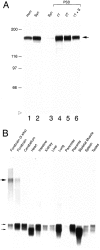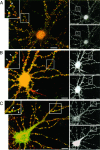Characterization of densin-180, a new brain-specific synaptic protein of the O-sialoglycoprotein family
- PMID: 8824323
- PMCID: PMC6579252
- DOI: 10.1523/JNEUROSCI.16-21-06839.1996
Characterization of densin-180, a new brain-specific synaptic protein of the O-sialoglycoprotein family
Abstract
We purified an abundant protein of apparent molecular mass 180 kDa from the postsynaptic density fraction of rat forebrain and obtained amino acid sequences of three tryptic peptides generated from the protein. The sequences were used to design a strategy for cloning the cDNA encoding the protein by polymerase chain reaction. The open reading frame of the cDNA encodes a novel protein of predicted molecular mass 167 kDa. We have named the protein densin-180. Antibodies raised against the predicted amino and carboxyl sequences of densin-180 recognize a 180 kDa band on immunoblots that is enriched in the postsynaptic density fraction. Immunocytochemical localization of densin-180 in dissociated hippocampal neuronal cultures shows that the protein is highly concentrated at synapses along dendrites. The message encoding densin-180 is brain specific and is more abundant in forebrain than in cerebellum. The sequence of densin-180 contains 17 leucine-rich repeats, a sialomucin domain, an apparent transmembrane domain, and a PDZ domain. This arrangement of domains is similar to that of several adhesion molecules, in particular GPIbalpha, which mediates binding of platelets to von Willebrand factor. We propose that densin-180 participates in specific adhesion between presynaptic and postsynaptic membranes at glutamatergic synapses.
Figures








References
-
- Andrews RK, Fox JEB. Identification of a region in the cytoplasmic domain of the platelet membrane glycoprotein-IB–IX complex that binds to purified actin-binding protein. J Biol Chem. 1992;267:18605–18611. - PubMed
-
- Brenman JE, Chao DS, Gee SH, McGee AW, Craven SE, Santillano DR, Wu Z, Huang F, Xia H, Peters MF, Froehner SC, Bredt DS. Interaction of nitric oxide synthase with the postsynaptic density protein PSD-95 and α-1-syntrophin mediated by PDZ domains. Cell. 1996;84:757–767. - PubMed
Publication types
MeSH terms
Substances
Associated data
- Actions
Grants and funding
LinkOut - more resources
Full Text Sources
Other Literature Sources
Molecular Biology Databases
